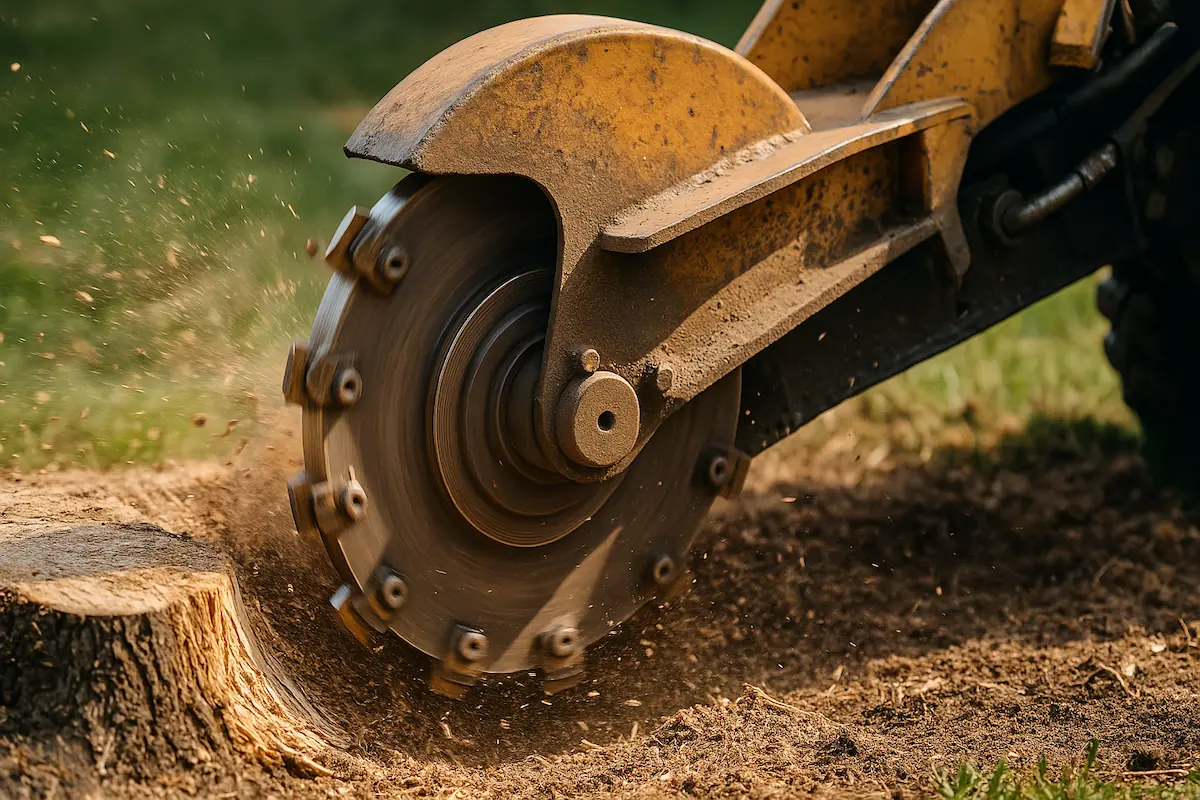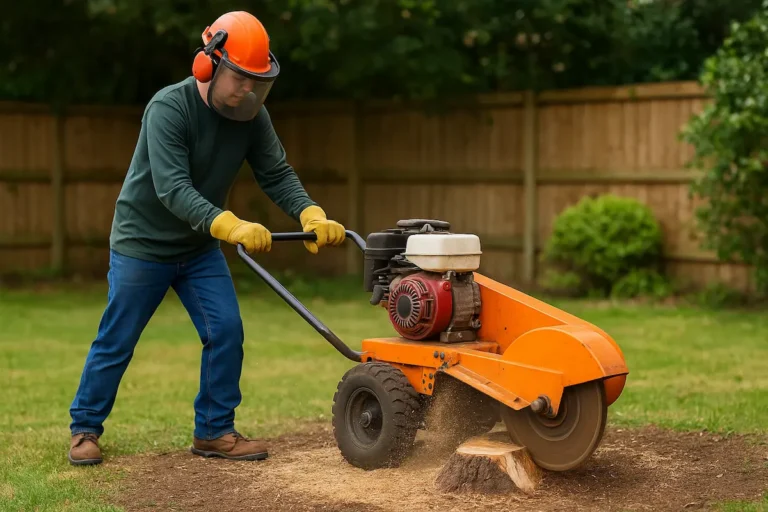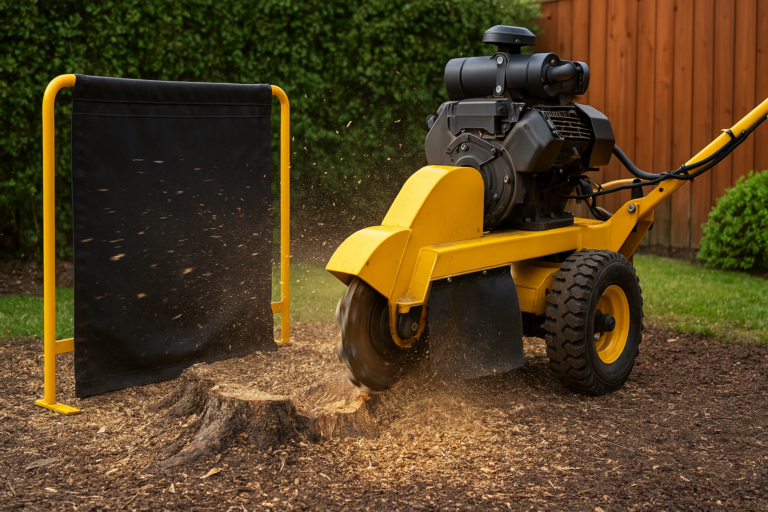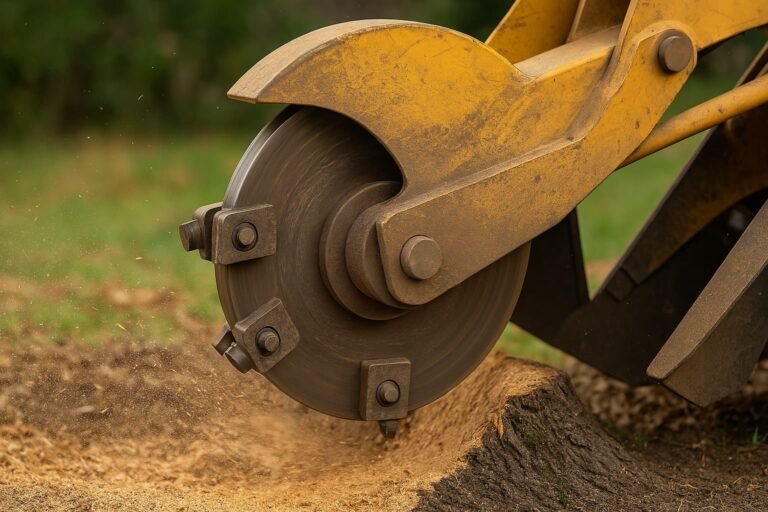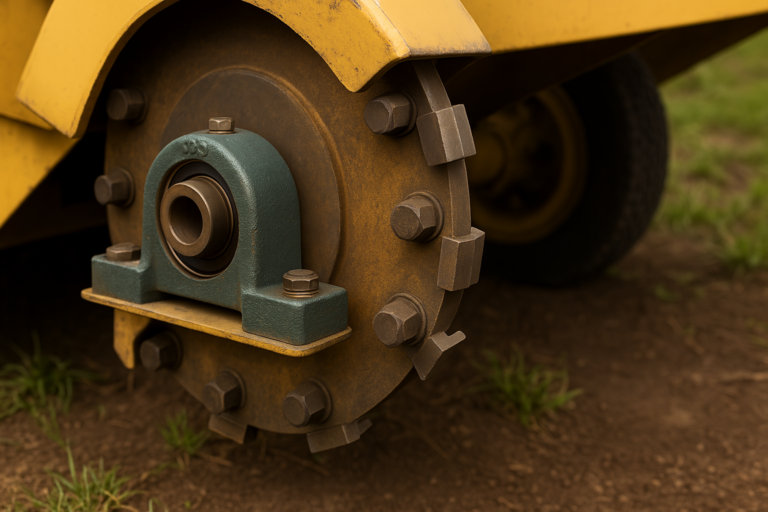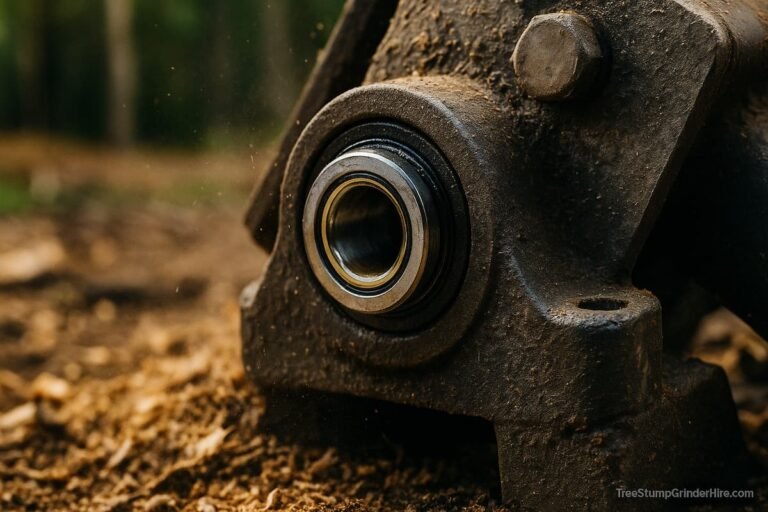Stump Grinder Teeth Cutters Explained: Get the Best Hire Experience
Hiring a stump grinder? Want your job done fast?
The teeth on the machine are super important.
Sharp teeth make grinding easy and quick.
Dull teeth make it slow and hard to work.
Key Takeaways: Tooth Condition Matters
- Grinding Speed: The chart clearly shows that sharp teeth result in significantly faster grinding compared to dull teeth. This aligns with the article stating sharp teeth can reduce grinding time by 25% to 50%.
- Efficiency & Effort: Faster grinding directly translates to less time spent on the job, reduced physical effort, and lower fuel consumption for the hire duration.
- Hire Experience: Choosing a hire company that maintains sharp teeth ensures a more productive, less frustrating, and potentially cheaper (due to shorter hire time) experience.
- Result Quality: Sharp teeth produce finer wood chips, leading to a cleaner finish and easier cleanup compared to the coarse chunks left by dull teeth.
What Exactly Are Stump Grinder Teeth (or Cutters)?
Stump grinder teeth are the sharp bits on the round cutting wheel.
Think of them like the blade on a saw.
They spin very fast and chew away at the wood of the tree stump.
These teeth are made to be tough, usually with tungsten carbide tips.
Tungsten carbide is a very hard material.
But, like any cutting tool, they wear down over time.
They are designed to be replaced when they get dull or damaged.
These teeth do all the real work of breaking down the stump.
Why Sharp Teeth Matter Massively for Your Stump Grinder Hire
Having sharp teeth on your hired stump grinder is a game-changer.
It directly affects how easy and successful your job will be.
Dull teeth cause lots of problems and waste your time.
Here’s why you want sharp teeth:
Grind Faster, Finish Sooner
This is the most significant benefit for you as a hirer.
Sharp teeth cut wood like a hot knife through butter.
They bite into the stump easily and remove wood quickly.
This means you spend much less time grinding.
“I hired a grinder once with dull teeth. It took me hours longer than the last time when the teeth were sharp. Never again!” – Common sentiment found on DIY forums.
Experts and experienced users often report that sharp teeth can cut grinding time significantly.
Some say sharp teeth can reduce grinding time by 25% to 50% compared to dull ones.
That’s a massive saving on a job you want finished!
Dull teeth scrape and rub the wood.
This makes the process incredibly slow and frustrating. Sharp teeth get the job done efficiently.
Save Effort and Reduce Strain
Grinding stumps can be physically demanding work.
A grinder with sharp teeth makes it much easier.
The machine works smoothly, gliding across the stump.
You don’t have to push or force the machine as hard.
Sharp teeth mean less vibration.
The grinder feels more stable and comfortable to operate.
Dull teeth cause the machine to bounce and vibrate more.
This makes you tired quickly and puts more strain on your body.
It also puts more strain on the machine’s engine and parts.
Sharp teeth lead to a smoother, less tiring experience.
Achieve a Cleaner, Tidier Result
Sharp teeth don’t just work faster, they work cleaner.
They produce fine wood chips, almost like sawdust.
This mulch is easier to handle and remove afterwards.
It can even be used in your garden if the wood is suitable.
Dull teeth rip and tear the wood.
They leave behind bigger chunks and stringy bits.
The ground finish can look rough and uneven.
Cleaning up larger chunks takes more effort.
Sharp teeth give a professional-looking finish.
Potentially Lower Your Overall Hire Cost
Stump grinders are usually hired for half-day or full-day work.
If sharp teeth help you finish the job twice as fast, you might save money.
You might only need a half-day hire instead of a full day.
Or you might finish well within your hired time slot.
Faster grinding also means the machine uses less fuel.
While fuel cost might not be huge, every little helps!
Using a machine with dull teeth means it runs for longer.
This uses more fuel and increases wear on the machine.
Most importantly, your time is valuable.
Sharp teeth save you time, which often saves you money.
Visual Guide: Spotting Good Teeth vs. Worn-Out Cutters
You don’t need to be an expert to spot good or rotten teeth.
Here’s a simple visual check you can do before you hire:
What Sharp, Effective Teeth Look Like:
- Sharp Edges: The cutting edges (usually carbide tips) should look crisp and defined.
- Pointed Corners: If the design has corners, they should be relatively sharp, not rounded off.
- Intact Carbide: The carbide tip should be fully present without large chips or cracks.
- Consistent Shape: All teeth should look similar in wear (though some wear slightly differently depending on position).
- Securely Bolted: Each tooth should be tightly bolted to the wheel.
Think: Does it look like it could cut wood easily?
Signs of Dull or Damaged Teeth to Watch For:
- Rounded Edges: The cutting edge looks smooth and rounded, like a worn coin edge. This is the most significant sign of dullness.
- Chipped Carbide: Small pieces of the carbide tip are broken off.
- Missing Carbide: Large parts of the carbide tip, or the entire tip, are gone.
- Cracked Tooth Body: Cracks in the steel part holding the carbide.
- Mushroomed Steel: The steel behind the carbide might look squashed or deformed from impact.
- Loose Bolts: Any sign that a tooth is not firmly attached.
Think: Does this look blunt or broken? Would it struggle to cut?
Quick Tip: Don’t hesitate to ask the hire shop staff about the teeth condition. A good hiring company wants you to have a good experience.
Common Problems Summary Box
| Problem with Teeth | What it Looks Like | Impact on Your Hire |
|---|---|---|
| Dull / Rounded | Smooth, blunt cutting edges | Very slow grinding, high vibration, hard work |
| Chipped Carbide | Small bits missing from tip | Less efficient cutting, can lead to more damage |
| Missing Carbide | Large part or whole tip gone | Very poor cutting, high vibration, uneven grind |
| Loose Bolt | Tooth wobbles or bolt looks loose | Safety Hazard! Tooth could fly off. |
| Cracked Tooth | Visible crack in steel/carbide | Safety Hazard! Tooth could break apart. |
Your Pre-Hire Check: Quickly Inspect the Grinder’s Teeth
Before you take the stump grinder away, do a quick visual check.
It only takes a minute and can save you hours of frustration.
You don’t need any tools for this.
- Safety First: Make sure the machine is switched off completely.
- Look Closely: Look at the teeth on the cutting wheel.
- Check for Sharpness: Do the edges look reasonably sharp or rounded? (Use the visual guide above.)
- Check for Damage: Check for chipped, cracked, or missing carbide tips.
- Check All Teeth Are Present: Count them quickly – make sure none are missing entirely.
- Check for Looseness: Do any teeth look loose, or are the bolts sticking out? (Don’t try to tighten them yourself; note if they look wrong.)
If many teeth look dull or damaged, raise your concerns with the hiring company.
A reputable hire service, like us at treestumpgrinderhire.com, prioritises good machine maintenance.
We know sharp teeth are essential for customer satisfaction.
This quick check helps ensure you get a machine ready for efficient work.
How Teeth Directly Impact Grinding Performance and Efficiency
We’ve said sharp teeth are faster, but let’s look closer.
The condition of the teeth changes how the whole machine operates.
Understanding this helps you see why checking them is worthwhile.
The Speed Difference: Sharp vs. Dull in Action
Imagine chopping vegetables.
A sharp knife slices cleanly and quickly.
A dull knife crushes the food and requires much more force.
It’s the same with stump grinder teeth.
Sharp teeth shear the wood fibres cleanly.
They pull themselves into the wood, making the grinder feed smoothly.
The engine runs more easily because it’s not straining against blunt resistance.
Dull teeth rub and scrape instead of cutting.
This creates a lot of friction and heat.
The grinder struggles to remove material.
You might hear the engine labouring or “bogging down””.
You must push harder and move the grinder more slowly across the stump.
The difference isn’t slight – it’s often very noticeable.
Reducing Machine Vibration and Wear
Smooth cutting with sharp teeth means less vibration.
The machine runs more happily.
This makes it more comfortable for you to use.
It also means less stress on the grinder’s components.
Bearings, belts, engine mounts, and the engine itself last longer.
Dull or damaged teeth cause significant vibration.
This jarring shakes the whole machine.
It increases the wear and tear on every part.
It makes the grinder louder and less pleasant to operate.
This increased stress is a key reason hiring companies should maintain sharp teeth.
It keeps their machines running reliably for longer.
And it gives you, the hirer, a better, more reliable tool for your job.
Common Types of Teeth You Might Find on Hire Stump Grinders
You might notice different styles of teeth on different grinders.
While the condition is most important, here’s a quick look at common types:
Understanding Standard (Conventional) Teeth
These are often square or rectangular carbide tips on a steel block (shank).
The whole unit bolts directly onto the cutting wheel.
They usually have one or two cutting edges per tooth.
When an edge gets dull, the tooth might need rotating (if possible) or replacing.
These are a traditional design found on many grinders.
They work well when sharp but can take longer to change or rotate.
Recognising Finger Teeth (e.g., Greenteeth®)
These are more modern and very popular designs.
You’ll often see systems like Greenteeth®, Yellow Jacket™, or Leonardi LoPro™.
They typically use a round carbide cutter that sits in a holder or “pocket””.
The clever part is that the round cutter usually has three sharp edges.
When one edge gets dull, you can loosen a screw and rotate the cutter to a fresh edge.
This is much faster than changing standard teeth.
Did You Know? Greenteeth® is incredibly popular. Many professional tree services and hire companies prefer them for their ease of use and multiple cutting edges per tooth.
Comments like “Once you switch to Greenteeth, you won’t go back” are common online.
These systems often provide excellent cutting performance and chip clearance.
They might look slightly different, but the principle is the same: they must be sharp!
Does the Tooth Type Really Matter for Your Hire?
Honestly, for most DIY hire jobs, the specific type of tooth isn’t the primary concern.
The most crucial factor is always the condition of the teeth.
Are they sharp and undamaged?
Both standard and finger teeth systems work very well when properly maintained.
Finger teeth systems like Greenteeth® might offer slightly faster cutting or smoother operation due to their design.
Hire companies often choose systems that are efficient for them to maintain.
This often means systems like Greenteeth®, where rotation is quick.
So, focus on checking the sharpness and condition, whatever the type looks like.
What Makes Stump Grinder Teeth Wear Out So Quickly?
Stump grinder teeth work in a harsh environment.
They hit wood and whatever is in the ground around the stump.
Understanding why they wear helps you use the machine carefully.
The Enemy Below: Soil, Rocks, and Hidden Debris
This is the number one cause of rapid tooth wear and damage.
Stumps rarely grow in clean, soft soil.
- Rocks: Hitting even small stones instantly dulls or chips carbide. Larger rocks can break teeth completely. This is a constant frustration for operators.
- Sand and Grit: Grinding below ground level means mixing soil with the wood chips. Sandy or gritty soil acts like sandpaper, rapidly wearing down the sharp edges.
- Clay: Heavy clay can pack around teeth, reducing cutting efficiency.
- Hidden Metal/Concrete: If hit, old fence posts, bits of rubble, or landscaping materials near the stump can cause severe damage.
Always clear the area around the stump as much as possible before starting.
Remove visible rocks, bricks, and other debris.
Be extra cautious when grinding near known obstacles like paths or walls.
Real Experience: Forum users frequently share pictures of teeth destroyed after hitting hidden concrete or large rocks. It’s a significant operational cost and concern.
How Different Wood Types Affect Wear
Wood itself causes wear, though usually slower than hitting rocks.
- Hardwoods: Oak, maple, or dense woods wear teeth faster than softwoods.
- Softwoods: Pine, fir, or cedar are generally easier on the teeth.
- Dirty Wood: Stumps with soil ingrained in the bark or roots will wear teeth faster.
Operator technique also plays a role.
Being too aggressive or forcing the grinder can accelerate wear.
Smooth, steady passes are usually best.
Safety First: Essential Checks Regarding Grinder Teeth
Teeth are not just about performance; they are critical for safety.
Damaged or poorly maintained teeth can be dangerous.
The Importance of Securely Fastened Teeth
Teeth spin at very high speeds on the cutting wheel.
Strong bolts hold on each tooth, tightened to a specific level (torque).
The tooth can fly off the wheel with incredible force if a bolt comes loose.
This turns the tooth into a dangerous projectile.
Hire companies must check bolt torque regularly as part of their maintenance.
As a hirer, quickly checking that no bolts look loose or missing is a basic safety scan.
Safety Fact: Manufacturer manuals and guidelines always stress the importance of regularly checking tooth bolt torque to prevent teeth from coming loose during operation.
Avoiding Damage That Creates Hazards
Hitting complex objects doesn’t just damage the tooth’s cutting ability.
It can cause cracks in the tooth body or the carbide.
A cracked tooth is weakened and could break apart during use.
Fragments could fly off, creating another projectile risk.
This is another reason to work carefully and avoid hitting rocks or concrete.
When operating a stump grinder, wear appropriate Personal Protective Equipment (PPE), including eye and hearing protection, sturdy trousers, and boots.
Our Commitment: We Ensure Sharp Teeth for Your Success
We know you’re hiring a stump grinder to get a job done effectively.
Slow grinding and frustration aren’t what you pay for.
That’s why we make sharp teeth a priority in our maintenance schedule.
- Regular Inspections: Our team checks the condition of every grinder’s teeth before and after each hire.
- Rotation & Replacement: We rotate finger teeth to fresh edges and promptly replace dull or damaged teeth. We don’t send out machines with badly worn cutters.
- Proper Torque: We ensure all tooth bolts are tightened correctly for safety and performance.
- Quality Parts: We use high-quality replacement teeth and bolts.
Why do we invest this time and effort?
Because sharp teeth mean:
- You finish your job faster.
- You have an easier, less tiring experience.
- You get a better result.
- Our machines run more reliably and safely.
- You’re more likely to be a happy customer and hire from us again!
Providing well-maintained equipment is key to a successful hire.
Sharp teeth are a crucial part of that commitment.
Frequently Asked Questions About Stump Grinder Teeth (for Hirers)
Here are answers to some common questions hirers ask about teeth:
Q1: Should I sharpen or change my teeth on a hired grinder?
A: Not! Maintaining the teeth (sharpening, rotating, replacing) is the responsibility of the hire company – that’s us. You need to operate the machine safely and effectively.
Q2: What happens if I hit a rock and damage a tooth?
A: Accidents happen, especially with hidden objects. Please inform us immediately if you know you’ve hit something problematic and suspect damage. Our hire agreement outlines policies regarding damage, which may involve the damage waiver options available. Honesty is the best policy here. Using a machine with badly damaged teeth can cause further problems and safety issues.
Q3: Can I request a grinder with a specific type of teeth (like Greenteeth®)?
A: Our fleet may have grinders with different tooth systems depending on the machine model and size. While we ensure all teeth are in good, sharp condition, guaranteeing a specific type might depend on availability for the machine size you need. Feel free to ask when booking, and we’ll advise you on what system is typically used on the grinder you’re hiring. Remember, sharp standard teeth work great too!
Q4: How long should a set of sharp teeth last during my hire?
A: This varies hugely! In clean soil and soft wood, teeth can last many hours. Edges can dull noticeably in rocky or sandy soil in less than an hour. Some sources mention 8- 20+ hours per edge in ideal conditions, but expect much less if you encounter rocks or debris. The key is careful operation and avoiding ground contact where possible.
Q5: Will dull teeth stop the grinder from working completely?
A: Usually not completely, unless they are excessively worn or damaged. However, they will make the grinder incredibly slow and inefficient. It will feel like you’re just polishing the stump instead of cutting it. It puts immense strain on the machine and the operator. If the performance drops drastically, it’s worth rechecking the teeth.
Ready to Hire a Stump Grinder with Effective Teeth?
Now you understand why sharp teeth are crucial for a successful stump grinder hire.
Don’t waste your time and effort fighting a machine with dull cutters.
Choose a hire company that prioritises machine maintenance.
We ensure our stump grinders have sharp, effective teeth that are ready to tackle your job.
Ready to get started?

